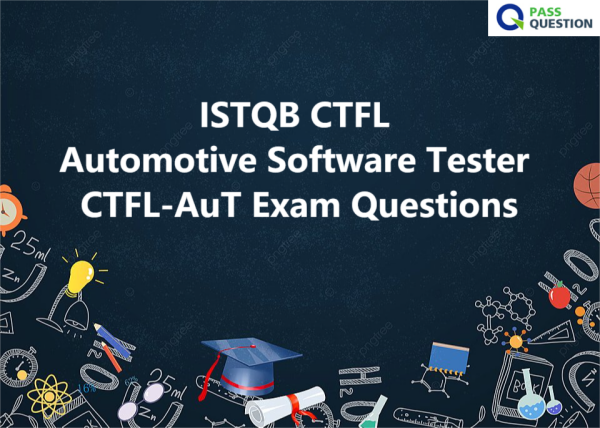ISTQB CTFL Automotive Software Tester CTFL-AuT Exam Questions
ISTQB Certified Tester Foundation Level - Automotive Software Tester CTFL-AuT exam is one of the most popular IT certifications. PassQuestion provides the latest ISTQB CTFL Automotive Software Tester CTFL-AuT Exam Questions for your best preparation. These CTFL-AuT Exam Questions are prepared by the top experts in the market who have best knowledge and skills to let the candidates achieve success in iSQI CTFL-AuT Exam. Practice in the ISTQB CTFL Automotive Software Tester CTFL-AuT Exam Questions gives chance to the candidates to improve their weaknesses and then attempt the CTFL-AuT exam with complete confidence and preparation.

CTFL-AuT Exam Overview - ISTQB Certified Tester Foundation Level - Automotive Software Tester
The ISTQB Certified Tester Automotive Software Tester (CTFL-AuT) certification focuses on the specific requirements for "testing E/E systems" in the automotive environment on the basis of established standards (Automotive SPICE, ISO 26262, AUTOSAR®, etc.). It also covers testing in virtual environments (including XiL), and automotive-specific static and dynamic test techniques.
The ISTQB CTFL Automotive Software Tester certification validates the skills of the professionals who are working within automotive projects. This certification is also beneficial for the ones who are planning to start the implementation of special automotive testing techniques in the near future. The certification trains you in Automotive activities, roles, techniques, and methodologies specific to the role of an Automotive Software Tester.
The Automotive Software Tester certification is aimed at anyone involved in software testing in the automotive area including testers, test analysts, test engineers, test consultants, test managers, release testers, and software developers. It may also be useful to people in the role of project manager, quality manager, software development manager, system analyst (business analysts), IT manager or management consultants, who wish to acquire basic knowledge and basic understanding of the topic software testing in the automotive area.
To gain this certification, candidates must hold the Certified Tester Foundation Level certificate.
Exam Structure
Number of Questions: 40 Multiple Choice
Total Points: 40
Passing Score: 65%
Exam Length (mins): 60 (+25% Non-Native Language)
Cost: $260USD
Language: English
Exam Outline
Module 1 – Introduction
1.1 Requirements from divergent project objectives and increasing product complexity
1.2 Project aspects influenced by standards
1.3 The six generic phases in the system lifecycle
1.4 The contribution/participation of the tester in the release process
Module 2 – Standards for the testing of E/E systems
2.1 Automotive SPICE (ASPICE)
2.2 ISO 26262
2.3 AUTOSAR
2.4 Comparison
Module 3 – Testing in a virtual environment
3.1 Test environment in general
3.2 Testing in XiL test environments
Module 4 – Automotive-specific static and dynamic test techniques
4.1 Static test techniques
4.2 Dynamic test techniques
View Online ISTQB CTFL Automotive Software Tester CTFL-AuT Free Questions
ISO 26262 recognizes several context factors which influence the selection of testing techniques. Which statement is correct? Please choose the BEST POSSIBLE answer.
A.An testing techniques are always applied to one test basis. The specific techniques, e.g. equivalence partition analysis, however, can always be applied.
B.ISO 26262 recommends specific testing techniques depending on the ASH level. Furthermore, the current state of technology must be considered
C.The risk assessment provides insights regarding the risks, whose causes will then be tested Intensively (independent of the testing technique).
D.For the selection and the applicability of the test techniques, the test basis is important, but not fie test level.
Answer : B
Which statement characterizes back-to-back testing?
A.Back-to-back testing is a variation of pair programming in which the testers should sit back to back to be able to work as independently as possible from each other.
B.Back-to-back testing compares test objects with mainly overlapping requirements to recognize the results of requirement change.
C.Back-to-back testing compares lest objects which are based on the same requirements.
D.Back-to-back testing compares different execution environments of the same test object
Answer : C
Which statement regarding requirements-based testing is true?
A.Requirements-based testing can be combined with other lest practices or testing techniques.
B.Requirements-based testing can solve issues like complete requirements
C.Only extensive and delated requirements can be covered completely by the tester.
D.Requirements-based testing is a testing technique
Answer : D
Which statement regarding the coding standard MlSRA-C:2012 Is true?
A.MISRA-C defines rules and guidelines. Rules are verifiable by static analysis tools and are always required.
B.MISRA-C defines rules and guidelines that are supposed to help avoid anomalies In object-oriented developed software (e.g. in C++)
C.MISRA-C defines rules that include among others that the source code should not include nested comments.
D.A typical rule in MISRA-C is that the developer has documented the implemented behavior wen.
Answer : B
Which statement regarding coding standards Is most true?
A.Coding standards should increase the maintainability of the source code.
B.Coding standards should educate the programmer
C.Coding standards should increase the efficiency of the programmer
D.Coding standards should increase the efficiency of the source code.
Answer : C
- TOP 50 Exam Questions
-
Exam
All copyrights reserved 2025 PassQuestion NETWORK CO.,LIMITED. All Rights Reserved.

